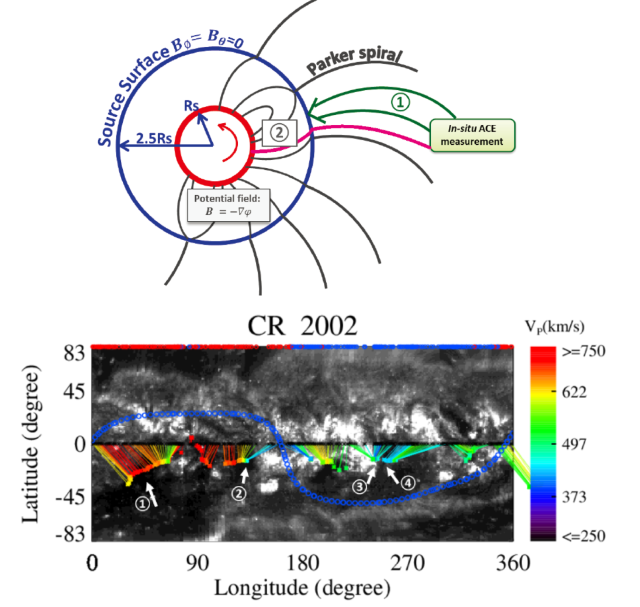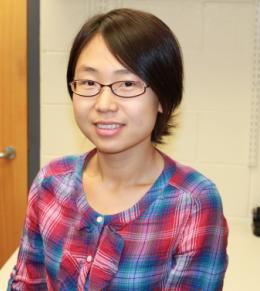时间……….....周三, 2017年9月13日, 下午 03:30-05:00 地点…….........物理大楼 北 415 讲座嘉宾….. ..赵亮 博士(密歇根大学) 讲座题目…… On the Relation of the in-situ Properties and Coronal Sources of the Solar Wind
摘要:
Because the solar wind charge state composition stops evolving at the freeze-in point (1.5~3.5 Rs) and remains unaltered all the way along its journey in the Heliosphere, both the element abundance and the charge states of solar wind heavy ions can be used as important diagnostic tools to investigate the properties of the different types of solar wind originating from distinct coronal origins. We categorize the types of solar wind using a new classification scheme based on the location of the wind's coronal source regions in the solar atmosphere and near-solar heliosphere. We first trace the solar wind measured by ACE/SWEPAM and SWICS from 1998 to 2011 at 1 AU back to a 2.5 Rs solar surface using ballistic mapping at constant proton speed; then we map them back to their magnetic foot points on the 1 Rs surface via the potential field source surface (PFSS) model. Coronal structures are identified using a classification scheme based on the pixel brightness in SOHO or STEREO EUV Carrington images. The angular distances between each mapped solar wind footpoint to the different coronal structure pixels are calculated and used as a criterion to identify the type of solar wind source region. Depending on the proximity of the solar wind footpoints to a given coronal or heliospheric structure, we classify the solar wind into six types: active region (AR), active region boundary (AR-boundary), quiet Sun (QS), coronal hole (CH), coronal hole boundary (CHboundary), and helmet-streamer associated wind. The in-situ properties (e.g., FIP bias) of these six types of solar wind and their solar cycle dependence are then examined and compared. The main results are: 1) The O7+/O6+ ratio is the most meaningful in-situ signature of all of the measured parameters discussed in this work for differentiating the solar wind types according to their different coronal origins. The six types of the solar wind can be nicely aligned as helmet-streamer, AR, AR-boundary, QS, CH-boundary, and CH winds, according to the monotonically decreasing order of the O7+/O6+ ratio. 2) Solar wind proton speed cannot be used as a reliable signature to differentiate the solar wind into different coronal source regions because a great amount of slow speed solar wind originates from the CHs and their boundaries. 3) The FIP effect is present in all six types of solar wind measured near the ecliptic, and the FIP bias factors of lowFIP elements are more enhanced in winds from hot coronal regions than in the other types of winds from cold coronal regions. 4. The influences of the strength of the solar cycle on the hot part of the corona and their associated winds are stronger than on the cold part of corona and their associated winds. The implication of this work and the future studies using measurements from Solar Orbiter and Parker Solar Probe will also be discussed.

图. 利用二步追踪法,对行星际的太阳风和源区日冕进行关联性研究 [引自Zhao L et al., ApJ, 2017]
讲座嘉宾介绍:
Education:
Ph.D, Univesity of Michigan, Ann Arbor, Michigan, 2011
(Thesis co-advisors: Dr. Lennard A. Fisk and Thomas H. Zurbuchen)
M.S(2005), B.S(2002), Peking University, Beijing, China
(advisor: Prof. Tu, Chuanyi)
Specializations and Research Interests:
Dynamics, composition, acceleration, heating and evolution of solar wind
Heliopsheric magnetic field
Spectroscopic observations
Honors, Awards and Accomplishments:
Selected as one of the ten winners of the Outstanding Postdoctoral Fellow Awards of the University of Michigan in 2015
NSF Atmospheric and Geospace Sciences Postdoctoral Research Fellowship 2014
Selected to attend the 2014 inaugural CAS-NAS (Chinese Academy of Sciences and U.S. National Academy of Sciences) Forum for New Leaders in Space Science, 2014.
NASA LWS Jack Eddy (Heliophysics) postdoctoral fellowship, Dec. of 2010-Mar. of 2013
NASA Earth and Space Science Fellowship (NESSF), 2009, and 2010
The First place of Michigan Geophysical Meeting (MGU) ---Thomas M. Donahue Memorial Student Award, at University of Michigan, 2009
The Dean fellowship at the Universityof Michigan, 2005
The "Excellent article of youth" award, by the Center for Space Science and Applied Research of Chinese Academy of Sciences, 2004.
The “May 4th Youth” scholarship for graduate student at Peking University of China, 2002-2003
The Excellent Student award at Peking University of China, 2002-2003
Professional Service:
Panelist for NASA and NSF proposal review panels.
Frequent reviewer of The Astrophysical Journal, Solar Physics, Science China Technological Sciences, Solar wind 12, 13 & 14 conference proceedings, the 12th international astrophysics conference proceeding, and also constantly serve as NCAR’s internal journal article reviewer.
Reviewer for NSF SHINE proposals
Reviewer for NSF postdoctral fellowship proposals
Session Chair: in the Flare/CME/Space Weather student session, in SHINE workshop Santa Fe, NM, 2010.
Class Instructor: For the class of “Physics of the Space Environment”, given by Prof. Tamas Gombosi, in the department of Atmospheric, Oceanic and Space Sciences at the University of Michigan, in the fall term of 2006, 2008, and 2009.
Outreach:
-
Volunteer in NCAR’s Supper Science Saturday event, on Oct. 29, 2011, Boulder, CO
Presenter at Career day event in Clague middle school, 2015 and 2017, Ann arbor, MI


